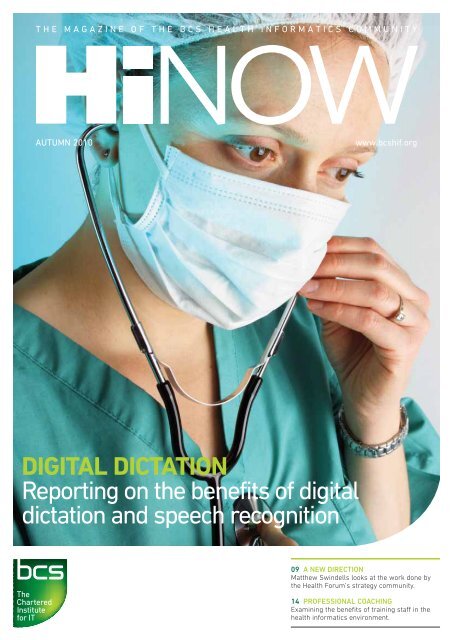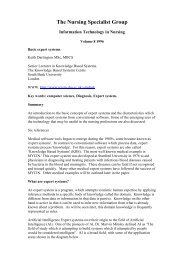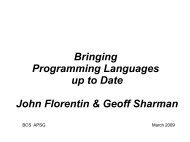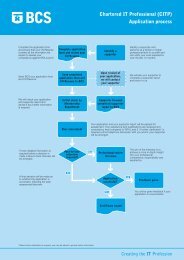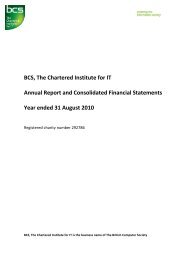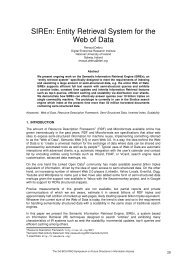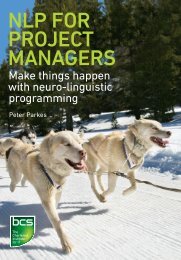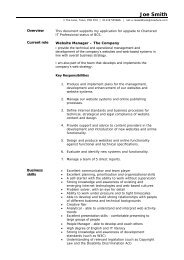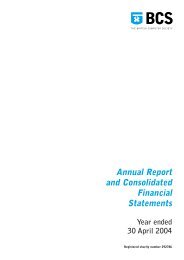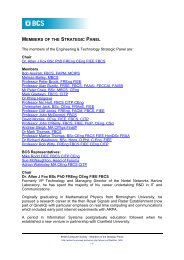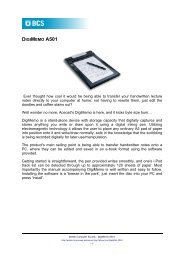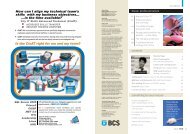DIGITAL DICTATION Reporting on the benefits of digital ... - BCS
DIGITAL DICTATION Reporting on the benefits of digital ... - BCS
DIGITAL DICTATION Reporting on the benefits of digital ... - BCS
Create successful ePaper yourself
Turn your PDF publications into a flip-book with our unique Google optimized e-Paper software.
THE MAGAZINE OF THE <strong>BCS</strong> HEALTH INFORMATICS COMMUNITY<br />
AUTUMN 2010 www.bcshif.org<br />
<str<strong>on</strong>g>DIGITAL</str<strong>on</strong>g> <str<strong>on</strong>g>DICTATION</str<strong>on</strong>g><br />
<str<strong>on</strong>g>Reporting</str<strong>on</strong>g> <strong>on</strong> <strong>the</strong> <strong>benefits</strong> <strong>of</strong> <strong>digital</strong><br />
dictati<strong>on</strong> and speech recogniti<strong>on</strong><br />
09 A NEW DIRECTION<br />
Mat<strong>the</strong>w Swindells looks at <strong>the</strong> work d<strong>on</strong>e by<br />
<strong>the</strong> Health Forum’s strategy community.<br />
14 PROFESSIONAL COACHING<br />
Examining <strong>the</strong> <strong>benefits</strong> <strong>of</strong> training staff in <strong>the</strong><br />
health informatics envir<strong>on</strong>ment.
ROUND-UP<br />
Sheila Bullas, Editorial Board Leader, HINOW, provides a glimpse <strong>of</strong> what’s in store for this issue.<br />
The summer holidays are over and <strong>the</strong>re is<br />
definitely a touch <strong>of</strong> autumn in <strong>the</strong> air – it’s<br />
time to get down to work.<br />
We have a mixed bag for you in this<br />
issue – or perhaps I should say a<br />
cornucopia - which we hope will delight.<br />
In previous issues we have described<br />
some <strong>of</strong> <strong>the</strong> changes to <strong>BCS</strong> Health. In this<br />
issue Chair <strong>of</strong> <strong>BCS</strong> Health, Mat<strong>the</strong>w<br />
02<br />
HINOW Autumn 2010<br />
Swindells, sets out priorities for <strong>the</strong> coming<br />
year based <strong>on</strong> work by <strong>the</strong> group’s strategy<br />
community under <strong>the</strong> leadership <strong>of</strong> Dr<br />
Justin Whatling. A new government means<br />
yet ano<strong>the</strong>r new opportunity for <strong>the</strong> NHS to<br />
get benefit out <strong>of</strong> its informati<strong>on</strong> systems.<br />
Will it take that opportunity? Mat<strong>the</strong>w and<br />
his colleagues would be pleased to hear<br />
your views. You can email us via <strong>the</strong> editor<br />
at HINOW (see below for <strong>the</strong> address).<br />
Digital dictati<strong>on</strong> and telecare<br />
The Nor<strong>the</strong>rn Specialist Group has been<br />
active as always. In this issue, Phil Paters<strong>on</strong><br />
reports <strong>on</strong> two <strong>of</strong> <strong>the</strong>ir recent meetings.<br />
The Clinical Advisory Team gave a roundup<br />
<strong>of</strong> some <strong>of</strong> <strong>the</strong> successful clinical<br />
informatics projects in <strong>the</strong> North West. In<br />
<strong>the</strong> sec<strong>on</strong>d report, <strong>benefits</strong> being achieved<br />
from various types <strong>of</strong> <strong>digital</strong> dictati<strong>on</strong><br />
technology are described.<br />
Keith Nurcomb gives a pers<strong>on</strong>al view <strong>on</strong><br />
why telecare and telehealth have not<br />
delivered <strong>the</strong> <strong>benefits</strong> that should be<br />
available. He goes <strong>on</strong> to describe what<br />
might be d<strong>on</strong>e about <strong>the</strong> situati<strong>on</strong>. We also<br />
have an article by Michael Bewel<br />
describing how coaching might help <strong>the</strong><br />
health informatician in <strong>the</strong>ir pr<strong>of</strong>essi<strong>on</strong>al<br />
and pers<strong>on</strong>al development.<br />
Last, but not least, Philip Scott reminds<br />
us that lack <strong>of</strong> evidence does not<br />
necessarily mean lack <strong>of</strong> benefit. He<br />
explains why <strong>the</strong> evidence is lacking: few<br />
people are keen to carry out <strong>the</strong> evaluati<strong>on</strong><br />
that <strong>the</strong>y have set out in <strong>the</strong>ir original<br />
plans, publicati<strong>on</strong>s <strong>on</strong> <strong>the</strong> topic are poor<br />
and <strong>the</strong> academic literature describing<br />
robust evaluati<strong>on</strong>s is not readily accessible.<br />
Philip explains what might be d<strong>on</strong>e to<br />
improve <strong>the</strong> situati<strong>on</strong>.<br />
And d<strong>on</strong>’t forget to check out <strong>the</strong> events<br />
secti<strong>on</strong> for <strong>BCS</strong> Health specialist group<br />
meetings coming up.<br />
WE WANT YOUR VIEWS<br />
HINOW provides an opportunity for<br />
you to exchange views or present<br />
your work. You might feel moved to<br />
submit an article or write to <strong>the</strong><br />
editor. We are keen to hear from you.<br />
What do you find most interesting<br />
about HINOW and what would you like<br />
to see in future issues? C<strong>on</strong>tact:<br />
justin.richards@hq.bcs.org.uk
EDITORIAL TEAM<br />
Justin Richards Editor<br />
Brian Runciman Managing Editor<br />
PRODUCTION TEAM<br />
Florence Leroy Producti<strong>on</strong> Manager<br />
FORUM MANAGER<br />
Graham McClaughlin 01793 417 723<br />
graham.mclaughlin@hq.bcs.org.uk<br />
EDITORIAL BOARD<br />
Sheila Bullas (leader), John Bryant,<br />
Keith Clough, Andrew Haw, Ian Herbert.<br />
Sue Kinn (News).<br />
HINOW is <strong>the</strong> quarterly publicati<strong>on</strong> <strong>of</strong> <strong>BCS</strong> health<br />
informatics community. It can also be viewed<br />
<strong>on</strong>line at: www.bcs.org/hinow<br />
Please note: The deadline for c<strong>on</strong>tributi<strong>on</strong>s for<br />
<strong>the</strong> Winter 2010 issue is 8 October 2010.<br />
Please send c<strong>on</strong>tributi<strong>on</strong>s to Justin Richards:<br />
justin.richards@hq.bcs.org.uk<br />
01793 417 618<br />
Registered charity no. 292786.<br />
The opini<strong>on</strong>s expressed herein are not<br />
necessarily those <strong>of</strong> <strong>BCS</strong> or <strong>the</strong> organisati<strong>on</strong>s<br />
employing <strong>the</strong> authors.<br />
© 2010 British Informatics Society Limited.<br />
Copying: Permissi<strong>on</strong> to copy for educati<strong>on</strong>al<br />
purposes <strong>on</strong>ly without fee all or part <strong>of</strong> this<br />
material is granted provided that <strong>the</strong> copies are<br />
not made or distributed for direct commercial<br />
advantage; British Informatics Society Limited<br />
copyright notice and <strong>the</strong> title <strong>of</strong> <strong>the</strong> publicati<strong>on</strong><br />
and its date appear; and notice is given that<br />
copying is by permissi<strong>on</strong> <strong>of</strong> British Informatics<br />
Society Limited. To copy o<strong>the</strong>rwise, or to<br />
republish, requires specific permissi<strong>on</strong> from <strong>the</strong><br />
publicati<strong>on</strong>s manager at <strong>the</strong> address below and<br />
may require a fee.<br />
Printed in <strong>the</strong> UK by Newnorth, Bedford.<br />
ISSN 1752-2390. Volume 5, Part 3.<br />
British Informatics Society Limited<br />
First Floor, Block D, North Star House,<br />
North Star Avenue, Swind<strong>on</strong>, SN2 1FA, UK.<br />
T +44 (0)1793 417 424<br />
F +44 (0)1793 417 444<br />
www.bcs.org/c<strong>on</strong>tactus<br />
Incorporated by Royal Charter 1984.<br />
CONTENTS<br />
06 <str<strong>on</strong>g>DIGITAL</str<strong>on</strong>g> <str<strong>on</strong>g>DICTATION</str<strong>on</strong>g><br />
The Nor<strong>the</strong>rn Specialist Group reports<br />
<strong>on</strong> <strong>the</strong> use <strong>of</strong> <strong>digital</strong> dictati<strong>on</strong> and<br />
speech/voice recogniti<strong>on</strong> in a number<br />
<strong>of</strong> hospitals around <strong>the</strong> UK.<br />
09 A NEW DIRECTION<br />
Mat<strong>the</strong>w Swindells, Chair <strong>of</strong> <strong>BCS</strong><br />
Health, sets out <strong>the</strong> priorities for <strong>the</strong><br />
coming year based <strong>on</strong> work by <strong>the</strong><br />
Health Forum’s strategy community.<br />
10 WHERE’S THE EVIDENCE?<br />
Philip Scott, University <strong>of</strong> Portsmouth,<br />
explains why <strong>the</strong> evidence for good<br />
health informatics is lacking and asks<br />
what can be d<strong>on</strong>e about it.<br />
13 HEALTH MANAGEMENT<br />
Keith Nurcombe, O2 Health, explains<br />
why he believes telecare and<br />
telehealth haven’t delivered yet.<br />
14 PROFESSIONAL COACHING<br />
Michael Bewell, Go MAD Thinking,<br />
takes a look at <strong>the</strong> <strong>benefits</strong> <strong>of</strong> coaching<br />
staff in <strong>the</strong> health informatics arena.<br />
16 THE START OF A NEW ERA<br />
Phil Paters<strong>on</strong> reports <strong>on</strong> <strong>the</strong> Clinical<br />
Advisory Team’s roundup <strong>of</strong> some <strong>of</strong><br />
<strong>the</strong> successful clinical informatics<br />
projects in <strong>the</strong> North West.<br />
19 EVENTS ROUNDUP<br />
A roundup <strong>of</strong> forthcoming events.<br />
Autumn 2010 HINOW 03
INDUSTRY NEWS<br />
MATURE DEBATE IS NEEDED<br />
Mat<strong>the</strong>w Swindells, Head <strong>of</strong> <strong>BCS</strong> Health, reflects <strong>on</strong> changes in NHS<br />
The ability to m<strong>on</strong>itor hospitals’<br />
performance has perversely led to a<br />
decline in public c<strong>on</strong>fidence in <strong>the</strong> NHS,<br />
according to Mat<strong>the</strong>w Swindells.<br />
Mat<strong>the</strong>w’s recent comments in Nati<strong>on</strong>al<br />
Health Executive coincide with a belief in<br />
04<br />
INFORMATION<br />
REVOLUTION<br />
HINOW Autumn 2010<br />
<strong>BCS</strong> Health for <strong>the</strong> need for a mature and<br />
h<strong>on</strong>est debate about <strong>the</strong> growing pains <strong>of</strong><br />
<strong>the</strong> informati<strong>on</strong> revoluti<strong>on</strong> inside <strong>the</strong> NHS.<br />
Increased accountability, such as <strong>the</strong><br />
opportunity to see mortality rate data, has<br />
resulted in higher standards <strong>of</strong> care.<br />
The future <strong>of</strong> Dr Foster Intelligence is under review<br />
According to <strong>the</strong> DOH, <strong>on</strong>e <strong>of</strong> <strong>the</strong> UK’s main<br />
providers <strong>of</strong> informati<strong>on</strong>, analysis and<br />
targeted communicati<strong>on</strong>s to health and<br />
social care organisati<strong>on</strong>s is under review.<br />
The review will explore strategic opti<strong>on</strong>s<br />
for <strong>the</strong> future <strong>of</strong> Dr Foster Intelligence. This<br />
follows <strong>the</strong> recent white paper 'Equity and<br />
Excellence: Liberating <strong>the</strong> NHS', which<br />
stated <strong>the</strong> government’s commitment to<br />
<strong>the</strong> introducti<strong>on</strong> <strong>of</strong> an NHS informati<strong>on</strong><br />
revoluti<strong>on</strong>, providing patients with quality<br />
informati<strong>on</strong> and data <strong>on</strong> all aspects <strong>of</strong><br />
healthcare.<br />
Combined with <strong>the</strong> right support, <strong>the</strong> aim<br />
is to increase <strong>the</strong> use <strong>of</strong> healthcare<br />
informatics to create better care, outcomes<br />
and reduced costs. The review will ensure<br />
that Dr Foster Intelligence is best placed to<br />
meet this challenge.<br />
Dr Foster Intelligence was launched in<br />
However, <strong>the</strong> public’s positive view <strong>of</strong> <strong>the</strong><br />
health service has in all likelihood<br />
diminished as a result <strong>of</strong> <strong>the</strong> statistics<br />
being published, said Mat<strong>the</strong>w.<br />
Informati<strong>on</strong> has become a doubleedged<br />
sword when it comes to<br />
administrative data, he believes.<br />
He said: ‘On <strong>the</strong> <strong>on</strong>e hand, we now have<br />
<strong>the</strong> ability to use data to track <strong>the</strong><br />
performance <strong>of</strong> NHS trusts with regards to<br />
things like mortality rates and this has<br />
enabled <strong>the</strong> public to hold <strong>the</strong> NHS to<br />
account far more effectively than ever<br />
before. Perversely though, this has<br />
probably led to a reducti<strong>on</strong> in public<br />
c<strong>on</strong>fidence in <strong>the</strong> health service,’<br />
Although <strong>the</strong> debate around <strong>the</strong><br />
implementati<strong>on</strong> <strong>of</strong> <strong>the</strong> nati<strong>on</strong>al patient<br />
records system has tended to dominate <strong>the</strong><br />
impressi<strong>on</strong> <strong>of</strong> ICT in <strong>the</strong> NHS, <strong>the</strong> last 10<br />
years have yielded many advancements in<br />
administrating healthcare.<br />
Mat<strong>the</strong>w predicted that <strong>the</strong> next decade<br />
will see <strong>the</strong> use <strong>of</strong> ICT to identify and target<br />
patients, allowing clinicians to intervene<br />
earlier in <strong>the</strong>ir disease or risk pr<strong>of</strong>iles in<br />
order to keep <strong>the</strong>m healthy, as opposed to<br />
reacting to when <strong>the</strong>y fall ill.<br />
Ano<strong>the</strong>r advance will be allowing patient<br />
records to follow <strong>the</strong> patient, ra<strong>the</strong>r than it<br />
being <strong>the</strong> o<strong>the</strong>r way around.<br />
Although this would enable care to be<br />
delivered in a more c<strong>on</strong>venient way, he<br />
acknowledged that safeguards must be in<br />
place to ensure <strong>the</strong> quality <strong>of</strong> data.<br />
He said: ‘You really do need to ensure<br />
that clinical informati<strong>on</strong> can move<br />
seamlessly around <strong>the</strong> patient. O<strong>the</strong>rwise<br />
you will have patients being treated in<br />
c<strong>on</strong>venient settings, but in an unsafe way.<br />
2006 as a joint venture between <strong>the</strong> NHS<br />
Informati<strong>on</strong> Centre and Dr Foster<br />
Holdings LLP. The NHS Informati<strong>on</strong><br />
Centre transferred its shareholding to <strong>the</strong><br />
Department <strong>of</strong> Health <strong>on</strong> 9 July 2010.<br />
This review is in line with <strong>the</strong><br />
government’s policy to maximise <strong>the</strong><br />
value <strong>of</strong> assets and commercial<br />
opportunities as explained in <strong>the</strong> findings<br />
<strong>of</strong> <strong>the</strong> Arm’s Length Bodies Review.<br />
Health Minister Sim<strong>on</strong> Burns said: ‘In<br />
<strong>the</strong> white paper Equity and Excellence:<br />
Liberating <strong>the</strong> NHS’, we set out a visi<strong>on</strong><br />
for an informati<strong>on</strong> revoluti<strong>on</strong> to give<br />
patients greater choice and c<strong>on</strong>trol. We<br />
will publish our informati<strong>on</strong> strategy<br />
paper in <strong>the</strong> autumn. This review will<br />
ensure that <strong>the</strong> Department <strong>of</strong> Health is<br />
making <strong>the</strong> most <strong>of</strong> Dr Foster<br />
Intelligence.’
The new NHS Wales internet site launches successfully<br />
The new Health in Wales bilingual website<br />
provides a single point <strong>of</strong> access for those<br />
seeking informati<strong>on</strong> about <strong>the</strong> health <strong>of</strong> <strong>the</strong><br />
people <strong>of</strong> Wales and informati<strong>on</strong> about <strong>the</strong><br />
health and social care services provided by<br />
NHS Wales.<br />
www.wales.nhs.uk is designed to<br />
complement NHS Direct Wales, which<br />
provides informati<strong>on</strong> for individuals and<br />
<strong>the</strong>ir dependents <strong>on</strong> pers<strong>on</strong>al health and<br />
heath service needs.<br />
The website has been developed and will<br />
be supported by Public Health Wales in<br />
partnership with a web team that is part <strong>of</strong><br />
NHS Wales Informatics Service.<br />
Am<strong>on</strong>g <strong>the</strong> main objectives <strong>of</strong> <strong>the</strong> site<br />
are to promote public and patient<br />
understanding <strong>of</strong> <strong>the</strong> NHS in Wales and to<br />
signpost opportunities for public and<br />
patient involvement in <strong>the</strong> NHS in Wales.<br />
The website was <strong>of</strong>ficially launched in<br />
March 2010 and has since been running<br />
successfully al<strong>on</strong>gside <strong>the</strong> HOWIS (Health<br />
<strong>of</strong> Wales Informati<strong>on</strong> Service) internet – <strong>the</strong><br />
website it was intended to replace. This has<br />
allowed time for full testing to take place.<br />
INDUSTRY NEWS<br />
Renal database<br />
A SUCCESSFUL LAUNCH Russells Hall Hospital is benefiting<br />
A COMPLETE SOLUTION<br />
Delivering dictati<strong>on</strong> and document management in Suffolk<br />
West Suffolk Hospital has elected SRC to<br />
deliver trust wide <strong>digital</strong> dictati<strong>on</strong> and<br />
document management.<br />
SRC, recently announced it is completing<br />
a trust wide deployment <strong>of</strong> <strong>the</strong> Winscribe<br />
<strong>digital</strong> dictati<strong>on</strong> system to 350 users, across<br />
29 specialities at West Suffolk Hospital<br />
(WSH).<br />
As well as deploying <strong>digital</strong> dictati<strong>on</strong>,<br />
SRC is also providing a full integrati<strong>on</strong> with<br />
<strong>the</strong> Trust’s Clinical Corresp<strong>on</strong>dence system.<br />
The system, which has been developed by<br />
strategic partner Bluewire Technologies, is<br />
already deployed and supported throughout<br />
<strong>the</strong> trust by SRC.<br />
By integrating <strong>digital</strong> dictati<strong>on</strong> and<br />
clinical corresp<strong>on</strong>dence, SRC is providing<br />
<strong>the</strong> Trust with a complete document<br />
management soluti<strong>on</strong>. Clinicians can create<br />
new dictati<strong>on</strong>s whilst reviewing patient<br />
details from within an applicati<strong>on</strong> that<br />
complies with Micros<strong>of</strong>t Health CUI<br />
standards for patient safety. Dictati<strong>on</strong>s,<br />
al<strong>on</strong>g with patient, hospital and GP data are<br />
<strong>the</strong>n automatically sent to secretaries for<br />
completi<strong>on</strong>. Draft documents can <strong>the</strong>n be<br />
electr<strong>on</strong>ically reviewed, approved and<br />
delivered to <strong>the</strong> GP or <strong>the</strong> end recipients.<br />
The soluti<strong>on</strong> also provides <strong>the</strong> trust with a<br />
full document repository and audit trail<br />
facility.<br />
Nick McD<strong>on</strong>nell, Head <strong>of</strong> IM&T, WSH said:<br />
‘In two m<strong>on</strong>ths, <strong>the</strong> soluti<strong>on</strong> has enabled us<br />
to cut turnaround times in cardiology and<br />
ENT by 2.36 days <strong>on</strong> average per letter. At<br />
<strong>the</strong> current rate <strong>of</strong> improvement, we predict<br />
turnaround times will be reduced even<br />
fur<strong>the</strong>r by <strong>the</strong> end <strong>of</strong> 2010.’<br />
from greater efficiency in renal<br />
patient management with <strong>the</strong><br />
installati<strong>on</strong> <strong>of</strong> new specialist<br />
s<strong>of</strong>tware. The eMEDRenal applicati<strong>on</strong><br />
from Mediqal H.I. was installed as<br />
part <strong>of</strong> Dudley’s 15-year IT services<br />
Managed Equipment Service (MES)<br />
agreement with Siemens Healthcare.<br />
Siemens Healthcare and Mediqal<br />
H.I. worked to ensure <strong>the</strong> smooth<br />
implementati<strong>on</strong> <strong>of</strong> <strong>the</strong> s<strong>of</strong>tware,<br />
which is a clinical patient database<br />
for renal specialities. eMEDRenal<br />
manages patient informati<strong>on</strong> from<br />
first referral through to dialysis,<br />
treatment and transplants.<br />
Technology at core<br />
A c<strong>on</strong>sortium <strong>of</strong> 10 NHS Trusts has<br />
put technology at <strong>the</strong> heart <strong>of</strong><br />
accelerated progress towards ‘cost<br />
per patient’ spending c<strong>on</strong>trol, in line<br />
with deficit linked public sector<br />
budget cuts.<br />
County Durham & Darlingt<strong>on</strong><br />
Foundati<strong>on</strong> Trust is extending its<br />
web-based e-procurement platform<br />
to 6,000 users and 3,000 suppliers,<br />
adding e-aucti<strong>on</strong> capabilities and<br />
planning <strong>on</strong>line supplier<br />
management.<br />
Full integrati<strong>on</strong> <strong>of</strong> its web3 best <strong>of</strong><br />
breed procurement soluti<strong>on</strong> with<br />
Oracle Financials, allows this<br />
procurement organisati<strong>on</strong> <strong>the</strong><br />
freedom to use advanced purchasing<br />
technology with seamless internal<br />
process. This is <strong>the</strong> latest stage in <strong>the</strong><br />
culminati<strong>on</strong> <strong>of</strong> a targets led 10 year<br />
plan to increase spending efficiency<br />
at CDDFT.<br />
Moti<strong>on</strong> sense<br />
Moti<strong>on</strong> sensing technologies, such as<br />
<strong>the</strong> Nintendo Wii Remote, could be<br />
used in <strong>the</strong> rehabilitati<strong>on</strong> <strong>of</strong> people<br />
with aphasia – a language<br />
impairment, <strong>of</strong>ten caused by a stroke.<br />
The research is being carried out at<br />
City University L<strong>on</strong>d<strong>on</strong>, in collaborati<strong>on</strong><br />
with The Stroke Associati<strong>on</strong> and<br />
funded by <strong>the</strong> Engineering and<br />
Physical Sciences Research Council<br />
(EPSRC). The aim is to develop an<br />
affordable, computer-based<br />
technology to help stroke survivors,<br />
who have limited spoken or written<br />
output, learn how to ‘gesture’<br />
independently at home. The project<br />
will create a prototype system that<br />
enables users to practice.<br />
Autumn 2010 HINOW 05
SPEECH RECOGNITION<br />
AND <str<strong>on</strong>g>DIGITAL</str<strong>on</strong>g> <str<strong>on</strong>g>DICTATION</str<strong>on</strong>g><br />
‘More for less’ is a current motif <strong>of</strong> <strong>the</strong> healthcare headlines. The use <strong>of</strong> <strong>digital</strong> dictati<strong>on</strong> and speech/voice<br />
recogniti<strong>on</strong> in hospitals around <strong>the</strong> UK is already dem<strong>on</strong>strating a rare combinati<strong>on</strong> – an increase in<br />
activity (productivity) and cash savings. The <strong>BCS</strong> Health Informatics Health (Nor<strong>the</strong>rn) Specialist Group<br />
tapped into local North West expertise to find out what is happening. Phil Paters<strong>on</strong> reports.<br />
The speakers at <strong>the</strong> Group’s meeting in<br />
February were Margaret Cosens, <strong>the</strong>n at<br />
NHS C<strong>on</strong>necting for Health and previously<br />
Programme Manager at The Countess <strong>of</strong><br />
Chester Hospital, and Keith Richards<strong>on</strong>,<br />
PACS, DD and VR Lead, Chief Informati<strong>on</strong><br />
and Knowledge Office, NHS North West.<br />
Margaret Cosens led a project at <strong>the</strong><br />
Countess <strong>of</strong> Chester Hospital to implement<br />
speech recogniti<strong>on</strong> in radiology. The results<br />
far outstripped expectati<strong>on</strong>s and led to<br />
o<strong>the</strong>r hospital clinicians asking to be<br />
included in <strong>the</strong> implementati<strong>on</strong>. She<br />
c<strong>on</strong>tended that NHS trusts now have a tool<br />
available to:<br />
reduce turn around times;<br />
help deliver <strong>the</strong> 18-week and o<strong>the</strong>r<br />
waiting times;<br />
reduce administrative costs – by a<br />
great deal;<br />
06 HINOW Autumn 2010<br />
free up skilled staff;<br />
enhance <strong>the</strong> delivery <strong>of</strong> high quality<br />
patient care.<br />
Keith Richards<strong>on</strong> is leading a project<br />
across <strong>the</strong> North West to promote <strong>the</strong><br />
<strong>digital</strong> management <strong>of</strong> corresp<strong>on</strong>dence<br />
[clinical letters, workflow, <strong>digital</strong> dictati<strong>on</strong>,<br />
voice recogniti<strong>on</strong> and electr<strong>on</strong>ic discharge<br />
management] in all 63 acute, mental<br />
health, and community trusts. Keith spoke<br />
about <strong>the</strong> current usage in <strong>the</strong> North West<br />
and <strong>the</strong> scale <strong>of</strong> <strong>the</strong> benefit that could be<br />
realised within <strong>the</strong> c<strong>on</strong>text <strong>of</strong> QIPP (quality,<br />
innovati<strong>on</strong>, productivity and preventi<strong>on</strong>).<br />
Margaret Cosens dem<strong>on</strong>strated speech<br />
recogniti<strong>on</strong> by speaking to <strong>the</strong> audience<br />
and giving c<strong>on</strong>trol commands to <strong>the</strong><br />
computer al<strong>on</strong>gside her, such as ‘Open’<br />
and ‘Close’. The s<strong>of</strong>tware included<br />
Micros<strong>of</strong>t Word and Outlook. Her words<br />
appeared <strong>on</strong> screen in a Word document<br />
immediately after she had spoken <strong>the</strong>m.<br />
This dem<strong>on</strong>strati<strong>on</strong> was performed using<br />
Talking Point s<strong>of</strong>tware. One <strong>of</strong> <strong>the</strong> c<strong>on</strong>trol<br />
commands is ‘change language’ which<br />
allows <strong>the</strong> user to switch from plain<br />
English to special terminologies such as<br />
clinical terminology for radiology reports.<br />
Margaret started <strong>on</strong> <strong>digital</strong> dictati<strong>on</strong> and<br />
speech recogniti<strong>on</strong> at <strong>the</strong> Countess <strong>of</strong><br />
Chester Hospital where speech recogniti<strong>on</strong><br />
was deployed as part <strong>of</strong> <strong>the</strong> PACS (Picture<br />
Archiving and Communicati<strong>on</strong>s System)<br />
project. The Speech Recogniti<strong>on</strong> System<br />
linked <strong>the</strong> PACS with <strong>the</strong> Radiology<br />
Informati<strong>on</strong> System (RIS) and became a<br />
treasured tool, providing <strong>the</strong> rare<br />
combinati<strong>on</strong> <strong>of</strong> clinical benefit and business<br />
benefit.<br />
The Countess <strong>of</strong> Chester Hospital was<br />
<strong>the</strong> first in <strong>the</strong> North West and West
Midlands cluster to implement <strong>the</strong> NHS<br />
Nati<strong>on</strong>al Programme for IT PACS, in July<br />
2006. The speech recogniti<strong>on</strong> programme<br />
started in 2006/7 and even before<br />
implementati<strong>on</strong> had been fully rolled-out<br />
<strong>the</strong>re was a queue <strong>of</strong> radiologists wanting<br />
to use it. Radiology reporting was<br />
automated and linked directly with <strong>the</strong> RIS.<br />
Radiologists could produce <strong>the</strong>ir reports<br />
<strong>the</strong>n sign <strong>the</strong>m <strong>of</strong>f straight away.<br />
The hospital measured <strong>the</strong> number <strong>of</strong><br />
days taken to get reports signed <strong>of</strong>f. Over<br />
<strong>the</strong> <strong>on</strong>e year 2006 – 2007, <strong>the</strong> use <strong>of</strong> <strong>digital</strong><br />
dictati<strong>on</strong> reduced average turnaround<br />
times from about seven days to three and a<br />
half days, and <strong>the</strong> additi<strong>on</strong> <strong>of</strong> speech<br />
recogniti<strong>on</strong> reduced this fur<strong>the</strong>r to between<br />
<strong>on</strong>e and <strong>on</strong>e and a half days. By September<br />
2008, 91 per cent <strong>of</strong> all <strong>the</strong> radiologists<br />
were reporting by speech recogniti<strong>on</strong>.<br />
Clinical and business <strong>benefits</strong><br />
Clinical <strong>benefits</strong> accrued because, after<br />
<strong>digital</strong> dictati<strong>on</strong> and speech recogniti<strong>on</strong><br />
were introduced <strong>on</strong> top <strong>of</strong> PACS, <strong>the</strong><br />
radiologists suffered far fewer n<strong>on</strong>-clinical<br />
interrupti<strong>on</strong>s. <str<strong>on</strong>g>Reporting</str<strong>on</strong>g> was quicker and<br />
<str<strong>on</strong>g>DIGITAL</str<strong>on</strong>g> <str<strong>on</strong>g>DICTATION</str<strong>on</strong>g><br />
The workload for <strong>the</strong> remaining staff went up in<br />
terms <strong>of</strong> numbers <strong>of</strong> reports each,but with<br />
<strong>digital</strong> dictati<strong>on</strong> and speech recogniti<strong>on</strong> making<br />
<strong>the</strong> job so much easier <strong>the</strong>re were no objecti<strong>on</strong>s.<br />
questi<strong>on</strong>s were fewer so <strong>the</strong>y could be<br />
clinically more productive.<br />
Business <strong>benefits</strong> were achieved<br />
through a big reducti<strong>on</strong> in staff costs. The<br />
annual cost <strong>of</strong> radiology department staff<br />
to type reports, etc was reduced from<br />
about £120,000 pa to £45,000 pa.<br />
Secretaries left naturally, but were not<br />
replaced. The workload for <strong>the</strong> remaining<br />
staff went up in terms <strong>of</strong> numbers <strong>of</strong><br />
reports each, but with <strong>digital</strong> dictati<strong>on</strong> and<br />
speech recogniti<strong>on</strong> making <strong>the</strong> job so<br />
much easier <strong>the</strong>re were no objecti<strong>on</strong>s.<br />
Take up<br />
Digital dictati<strong>on</strong> users have got a mix <strong>of</strong><br />
two products, Winscribe and Talking Point.<br />
Take-up was fast and <strong>the</strong>re was a 30 per<br />
cent saving in costs. The speech<br />
recogniti<strong>on</strong> take-up was slower. The key to<br />
<strong>the</strong> success <strong>of</strong> speech recogniti<strong>on</strong> was<br />
PACS. Speech recogniti<strong>on</strong> suddenly<br />
became beneficial as radiologists could<br />
write <strong>the</strong>ir own reports al<strong>on</strong>gside <strong>the</strong><br />
scanned patient images in <strong>the</strong>ir own <strong>of</strong>fice.<br />
The hospital moved <strong>on</strong> to hospital-wide<br />
<strong>digital</strong> corresp<strong>on</strong>dence, <strong>the</strong> principal<br />
drivers being:<br />
to reduce <strong>the</strong> time for key clinical<br />
informati<strong>on</strong> to get to GPs or o<strong>the</strong>r<br />
requestors to within 24 hours;<br />
to release senior secretarial staff to<br />
manage patient care activities and <strong>the</strong><br />
overall business;<br />
to reduce staff costs by providing<br />
support for typists.<br />
The Hospital uses MedisecNET, which<br />
captures clinical letters from PAS (e.g.<br />
outpatient clinic letters) and sends <strong>the</strong>m to<br />
over 100 GP surgeries in Cheshire. The<br />
implementati<strong>on</strong> rollout needs handholding,<br />
pers<strong>on</strong>al support, and encouragement to<br />
clinicians. Speech recogniti<strong>on</strong> results in<br />
reports being ready <strong>the</strong> same day, at <strong>the</strong><br />
end <strong>of</strong> a clinic, produced and signed <strong>of</strong>f by<br />
<strong>the</strong> clinician. Digital dictati<strong>on</strong> results in<br />
letters being signed <strong>of</strong>f a few days later,<br />
but it too speeds up <strong>the</strong> typing process.<br />
There are challenges:<br />
funding for <strong>the</strong> products and <strong>the</strong> people<br />
– needs a commitment to support <strong>the</strong><br />
implementati<strong>on</strong> before <strong>the</strong> benefit is<br />
delivered and to <strong>the</strong> <strong>on</strong>going, recurring<br />
costs, as well as finding <strong>the</strong> capital;<br />
visi<strong>on</strong> – letting o<strong>the</strong>rs catch it, <strong>the</strong> heart<br />
<strong>of</strong> change management;<br />
time – resisting <strong>the</strong> pressures to pull<br />
away from it.<br />
The big positive is that <strong>the</strong> technology<br />
works and, with a robust approach, every<br />
trust could reduce <strong>the</strong>ir turnaround times,<br />
help deliver waiting time targets, reduce<br />
administrati<strong>on</strong> costs by a great deal, free<br />
up skilled staff and enhance patient care.<br />
Transformati<strong>on</strong>al projects<br />
Keith Richards<strong>on</strong> explained that he was<br />
now working at <strong>the</strong> NHS Northwest<br />
Strategic Health Authority, but that he had<br />
also worked at <strong>the</strong> Countess <strong>of</strong> Chester<br />
Hospital and was a supporter and<br />
enthusiast for <strong>digital</strong> dictati<strong>on</strong> and voice<br />
recogniti<strong>on</strong>. This area has been identified<br />
by NHS Northwest as <strong>on</strong>e <strong>of</strong> <strong>the</strong> ‘Top 10<br />
Transformati<strong>on</strong>al Projects’ under <strong>the</strong> QIPP<br />
Programme.<br />
The NHS in <strong>the</strong> North West produces<br />
about 15 milli<strong>on</strong> letters per annum, about<br />
half <strong>of</strong> which are dictated by a clinician.<br />
Some 63 NHS trusts communicate with<br />
1,315 GP practices which receive an<br />
average <strong>of</strong> 5,750 clinical letters a year<br />
each, or 110 per week.<br />
The c<strong>on</strong>sequences at <strong>the</strong> GP practice are<br />
that practice staff currently spend about<br />
five hours a day processing and scanning<br />
paper clinical letters received from<br />
hospitals into <strong>the</strong>ir GP computer systems.<br />
In <strong>the</strong> North West that equates to 812 staff,<br />
costing about £16.25 milli<strong>on</strong> a year, simply<br />
processing hospital-generated paper.<br />
The c<strong>on</strong>sequences for hospitals are that<br />
staff are employed stuffing envelopes at a<br />
cost <strong>of</strong> about £60,000 a year per hospital.<br />
About 75 per cent <strong>of</strong> letters are sent with<br />
hospital transport such as <strong>the</strong> pathology<br />
tests pickup van but <strong>the</strong> rest are posted –<br />
costing about £1 milli<strong>on</strong> a year per trust<br />
for postage.<br />
One opti<strong>on</strong> is to try to move <strong>the</strong> trusts<br />
and GP practices to improve <strong>on</strong> <strong>the</strong><br />
traditi<strong>on</strong>al, paper-based process. Digital<br />
dictati<strong>on</strong> <strong>of</strong>fers more methods for<br />
dictati<strong>on</strong>, at <strong>the</strong> <strong>of</strong>fice or home or <strong>on</strong> <strong>the</strong><br />
move, with reports going <strong>on</strong>to a computer<br />
network, with an interface to PAS for<br />
demographics and reference data, which<br />
gives more opti<strong>on</strong>s for typing – again at<br />
<strong>the</strong> <strong>of</strong>fice, home or remote. After initial<br />
transcripti<strong>on</strong> what is required is an editor<br />
more than a typist, who can email a<br />
Autumn 2010 HINOW 07
document to <strong>the</strong> author for <strong>on</strong>line review<br />
and sign-<strong>of</strong>f. The process becomes <strong>on</strong>e <strong>of</strong><br />
e-letters, e-processed.<br />
A more advanced opti<strong>on</strong> is to replace <strong>the</strong><br />
secretary with a background computer and<br />
<strong>the</strong> pers<strong>on</strong> who dictates <strong>the</strong> report edits it<br />
via <strong>on</strong>line access – but <strong>the</strong> c<strong>on</strong>sultants<br />
want to keep <strong>the</strong>ir secretaries. A fur<strong>the</strong>r<br />
opti<strong>on</strong>, in radiology, has <strong>the</strong> c<strong>on</strong>sultants<br />
dictating directly <strong>on</strong>to <strong>the</strong> screen using<br />
voice recogniti<strong>on</strong> technology; <strong>the</strong>y can<br />
verify <strong>the</strong>ir reports, sign <strong>the</strong>m <strong>of</strong>f and send<br />
<strong>the</strong>m to <strong>the</strong> GP practice <strong>the</strong> same day. Both<br />
<strong>the</strong>se opti<strong>on</strong>s present cultural challenges.<br />
Resp<strong>on</strong>ses vary with exposure to change,<br />
IT awareness etc.<br />
Digitised reports and letters enable <strong>the</strong><br />
c<strong>on</strong>cept <strong>of</strong> an integrated clinical<br />
communicati<strong>on</strong>s hub between hospitals<br />
and GP practices, routing electr<strong>on</strong>ic letters<br />
to <strong>the</strong> right place. Cheshire trusts are using<br />
this approach to send e-discharge letters.<br />
C<strong>on</strong>sistency is all<br />
Typing errors can arise due to <strong>the</strong> author <strong>of</strong><br />
a letter typing and sending it <strong>of</strong>f without a<br />
pro<strong>of</strong> reader. You do see what you hear<br />
yourself say. Some radiologists will dictate,<br />
leave it for a while, and come back to <strong>the</strong>ir<br />
reports as a batch at <strong>the</strong> end <strong>of</strong> a sessi<strong>on</strong>.<br />
Systems are voice-pr<strong>of</strong>ile based and<br />
very quickly pick up <strong>the</strong> pr<strong>of</strong>ile for new<br />
users. C<strong>on</strong>sistency is a factor. The systems<br />
are very accurate. Micros<strong>of</strong>t Windows 7<br />
includes free voice recogniti<strong>on</strong> s<strong>of</strong>tware.<br />
Basic pr<strong>of</strong>essi<strong>on</strong>al voice recogniti<strong>on</strong><br />
s<strong>of</strong>tware is commercially available for<br />
about £300 to £650.<br />
What is <strong>the</strong> difference between <strong>digital</strong><br />
dictati<strong>on</strong> and speech/voice recogniti<strong>on</strong>?<br />
The more established approach is to<br />
dictate to a tape and give it to a typist.<br />
Tapes are <strong>the</strong>n stored until <strong>the</strong> typist has<br />
time to get round to <strong>the</strong>m.<br />
If <strong>the</strong> c<strong>on</strong>sultant wants a particular<br />
report to be found and typed urgently, it can<br />
take <strong>the</strong> typist hours to search all <strong>the</strong> tapes<br />
to find <strong>the</strong> right <strong>on</strong>e. Work scheduling is<br />
disrupted. This technology uses analogue<br />
recording to tape. Most <strong>of</strong> <strong>the</strong> NHS is still<br />
<strong>on</strong> this old technology.<br />
Going <strong>digital</strong><br />
Digital dictati<strong>on</strong>, which really came in with<br />
PACS, produces a ‘<strong>digital</strong> tape’ instead <strong>of</strong> an<br />
analogue tape. Digital recordings can be<br />
stored <strong>on</strong> a computer network and made<br />
available wherever is most appropriate<br />
for typing.<br />
The c<strong>on</strong>sultant talks, a <strong>digital</strong> recording<br />
is produced and <strong>the</strong> secretary types it. The<br />
secretary gets an indexed list <strong>of</strong> dictated<br />
letters with priority reports highlighted in<br />
red at <strong>the</strong> top <strong>of</strong> <strong>the</strong> list. Management can<br />
provide performance statistics <strong>on</strong><br />
turnaround times etc.<br />
08 HINOW Autumn 2010<br />
Speech-to-text<br />
Speech-to-text technology allows a<br />
secretary to open up some hard-tounderstand<br />
reports to find keywords that<br />
are c<strong>on</strong>verted to text – <strong>the</strong> words are typed<br />
out for <strong>the</strong> secretary – allowing <strong>the</strong><br />
secretary to edit this into a proper report.<br />
<str<strong>on</strong>g>DIGITAL</str<strong>on</strong>g> <str<strong>on</strong>g>DICTATION</str<strong>on</strong>g><br />
Digitised reports and letters enable <strong>the</strong> c<strong>on</strong>cept<br />
<strong>of</strong> an integrated clinical communicati<strong>on</strong>s hub<br />
between hospitals and GP practices, routing<br />
electr<strong>on</strong>ic letters to <strong>the</strong> right place.<br />
Speech/voice recogniti<strong>on</strong> takes it fur<strong>the</strong>r<br />
and provides a full process. The words<br />
come straight back <strong>on</strong> screen for <strong>the</strong><br />
clinician to read and edit <strong>on</strong> <strong>the</strong> spot.<br />
For fur<strong>the</strong>r informati<strong>on</strong> please visit:<br />
www.hinorth.bcs.org.uk
<strong>BCS</strong> HEALTH COMMENT<br />
A NEW DIRECTION FOR HI?<br />
<strong>BCS</strong> Health wants to place itself in a positi<strong>on</strong> to have a positive<br />
influence <strong>on</strong> government policies relating to healthcare in <strong>the</strong> future.<br />
Mat<strong>the</strong>w Swindells, Chair, <strong>BCS</strong> Health, c<strong>on</strong>siders <strong>the</strong> areas <strong>the</strong> health<br />
informatics community need to prioritise over <strong>the</strong> coming m<strong>on</strong>ths.<br />
The publicati<strong>on</strong> <strong>of</strong> <strong>the</strong> white paper, ‘Equity<br />
and excellence: Liberating <strong>the</strong> NHS’ in July<br />
2010 promised ‘an informati<strong>on</strong> revoluti<strong>on</strong>’<br />
to drive better care and reduce cost. It also<br />
promised an informati<strong>on</strong> strategy for <strong>the</strong><br />
NHS, which is being written at <strong>the</strong> moment,<br />
due for publicati<strong>on</strong> in <strong>the</strong> autumn.<br />
This presents an opportunity for <strong>the</strong> NHS<br />
to adopt an approach that places<br />
informati<strong>on</strong> at <strong>the</strong> heart <strong>of</strong> transforming<br />
<strong>the</strong> delivery <strong>of</strong> health care, <strong>the</strong> planning <strong>of</strong><br />
health services and, perhaps most<br />
importantly, <strong>the</strong> empowerment <strong>of</strong> patients<br />
to take c<strong>on</strong>trol <strong>of</strong> <strong>the</strong>ir own health, <strong>the</strong> care<br />
<strong>the</strong>y receive, and to hold <strong>the</strong> NHS to<br />
account.<br />
<strong>BCS</strong> Health wants to place itself at <strong>the</strong><br />
forefr<strong>on</strong>t <strong>of</strong> this revoluti<strong>on</strong>. We see <strong>the</strong><br />
c<strong>on</strong>tributi<strong>on</strong> that we can make through <strong>the</strong><br />
expertise <strong>of</strong> our membership to help <strong>the</strong><br />
government develop a coherent informati<strong>on</strong><br />
strategy, help <strong>the</strong> NHS implement that<br />
strategy adroitly, and help informatics<br />
pr<strong>of</strong>essi<strong>on</strong>als rise to <strong>the</strong> challenge <strong>of</strong><br />
leading <strong>the</strong> informati<strong>on</strong> revoluti<strong>on</strong>.<br />
But, we d<strong>on</strong>’t want <strong>the</strong> <strong>BCS</strong> agenda to be<br />
determined entirely by publicati<strong>on</strong>s<br />
emanating from Whitehall. C<strong>on</strong>sequently,<br />
<strong>BCS</strong> Health’s Policy and Strategy<br />
Community, under <strong>the</strong> leadership <strong>of</strong> Dr<br />
Justin Whatling have prioritised three areas<br />
for work in <strong>the</strong> next 12 m<strong>on</strong>ths:<br />
1. Preparing for informati<strong>on</strong> being<br />
missi<strong>on</strong>-critical to <strong>the</strong> NHS<br />
We all know that <strong>the</strong> data up<strong>on</strong> which <strong>the</strong><br />
government wants to build its informati<strong>on</strong><br />
revoluti<strong>on</strong> is not <strong>of</strong> as high a quality as we<br />
would want. However, <strong>BCS</strong> Health believes<br />
that <strong>the</strong> <strong>on</strong>ly way to improve data quality is<br />
to expose it to clinicians, managers and <strong>the</strong><br />
public. However, this is a risky approach,<br />
with <strong>the</strong> potential that <strong>the</strong> public or media<br />
may jump to c<strong>on</strong>clusi<strong>on</strong>s that can’t be<br />
sustained by <strong>the</strong> data.<br />
<strong>BCS</strong> will proactively try to smooth<br />
progress and build an understanding in <strong>the</strong><br />
NHS, <strong>the</strong> supplier community and <strong>the</strong><br />
public, anticipating and expecting that<br />
informati<strong>on</strong> will be wr<strong>on</strong>g at first, but that<br />
we have to work through that phase to get<br />
<strong>the</strong> <strong>benefits</strong>, without a witch hunt.<br />
We will also support <strong>the</strong> creati<strong>on</strong> <strong>of</strong> a<br />
robust informati<strong>on</strong> governance and<br />
c<strong>on</strong>sent policy – no <strong>on</strong>e has yet achieved<br />
this and it is critical to progress.<br />
2. Driving integrati<strong>on</strong> and interoperability<br />
through opening up systems<br />
Al<strong>on</strong>gside open informati<strong>on</strong> comes <strong>the</strong><br />
need for open systems. The redesign <strong>of</strong><br />
health systems, optimising care pathways<br />
and delivering more care outside hospitals<br />
will all require collaborative working<br />
between instituti<strong>on</strong>s and <strong>the</strong> sharing <strong>of</strong><br />
informati<strong>on</strong>. This cannot be d<strong>on</strong>e by simply<br />
standardising <strong>the</strong> s<strong>of</strong>tware vendors; it will<br />
require integrati<strong>on</strong> and interoperability.<br />
<strong>BCS</strong> will encourage <strong>the</strong> mandatory use<br />
and publicati<strong>on</strong> <strong>of</strong> interfaces (APIs) for all<br />
informatics systems used in <strong>the</strong> NHS. <strong>BCS</strong><br />
will pragmatically support <strong>the</strong> use <strong>of</strong><br />
existing standards to release rapid <strong>benefits</strong>.<br />
3. Patient engagement and self service<br />
The step change in productivity that <strong>the</strong><br />
NHS needs will require patients to become<br />
more involved in managing <strong>the</strong>ir own<br />
illnesses and reducing <strong>the</strong>ir health risk.<br />
Patients will expect and need tools for<br />
self-service <strong>of</strong> <strong>the</strong> same standard that <strong>the</strong>y<br />
see in o<strong>the</strong>r sectors. <strong>BCS</strong> will help<br />
articulate <strong>the</strong> value propositi<strong>on</strong> for patient<br />
engagement, helping <strong>the</strong>m understand <strong>the</strong><br />
<strong>benefits</strong> and risks and enabling <strong>the</strong>m to<br />
take a balanced view <strong>on</strong> <strong>the</strong>ir level <strong>of</strong><br />
engagement.<br />
This is an exciting agenda for<br />
informatics pr<strong>of</strong>essi<strong>on</strong>als in health. <strong>BCS</strong><br />
will be doing its best to advise <strong>the</strong><br />
government, support <strong>the</strong> NHS and develop<br />
informaticians to meet <strong>the</strong> challenge. I<br />
hope you will look for ways in which you<br />
too can c<strong>on</strong>tribute.<br />
ADDITIONAL INFO<br />
For more informati<strong>on</strong> regarding<br />
<strong>BCS</strong> Health please visit:<br />
www.bcs.org/health<br />
AUTUMN 2010 HINOW 09
HEALTH INFORMATICS:<br />
WHERE’S THE<br />
EVIDENCE?<br />
It is a l<strong>on</strong>g-lamented fact that UK healthcare abounds with evidence <strong>of</strong> good and bad practice in health<br />
informatics that is never reported bey<strong>on</strong>d its immediate project c<strong>on</strong>text. UK health informatics largely<br />
remains a field without a memory. Dr Philip Scott, Senior Lecturer, Centre for Healthcare Modelling and<br />
Informatics, University <strong>of</strong> Portsmouth, summarises a report commissi<strong>on</strong>ed by <strong>the</strong> UK Faculty <strong>of</strong> Health<br />
Informatics to make recommendati<strong>on</strong>s about how <strong>the</strong> health informatics evidence base can be improved<br />
in c<strong>on</strong>tent and disseminated more widely and effectively.<br />
Firstly, <strong>on</strong>ly a small proporti<strong>on</strong> <strong>of</strong><br />
informatics innovati<strong>on</strong>s in <strong>the</strong> NHS are<br />
properly evaluated or reported. Even<br />
though standard project management<br />
methodologies include post-project<br />
reviews, it is comm<strong>on</strong> knowledge that <strong>the</strong>y<br />
seldom occur and, even more infrequently,<br />
get placed in <strong>the</strong> public domain. We call this<br />
<strong>the</strong> missed evidence problem.<br />
Sec<strong>on</strong>dly, <strong>the</strong> academic literature is not<br />
readily accessible to policy makers and<br />
service managers due to its volume and<br />
sometimes impenetrable discourse. The<br />
purpose <strong>of</strong> some academic publicati<strong>on</strong><br />
seems to be more about satisfying<br />
research-counting exercises than<br />
disseminating knowledge. We call this <strong>the</strong><br />
lost evidence problem.<br />
Thirdly, <strong>the</strong> published research evidence<br />
10 HINOW Autumn 2010<br />
in health informatics is <strong>of</strong> variable quality<br />
and limited provenance 1 .<br />
One literature review noted that<br />
approximately 80 per cent <strong>of</strong> <strong>the</strong> evidence<br />
base is from <strong>the</strong> USA, <strong>of</strong> which about 27<br />
per cent is from six leading instituti<strong>on</strong>s<br />
with decades <strong>of</strong> experience with homegrown<br />
systems. Al<strong>on</strong>g with <strong>the</strong> complex<br />
nature <strong>of</strong> <strong>the</strong> healthcare envir<strong>on</strong>ment, this<br />
has prevented <strong>the</strong> robust inference <strong>of</strong><br />
general recommendati<strong>on</strong>s. We call this <strong>the</strong><br />
incomplete evidence problem.<br />
We suggest that <strong>the</strong>re are two key<br />
weaknesses underlying all <strong>the</strong>se evidence<br />
problems.<br />
Knowledge-sharing culture<br />
There is an active community <strong>of</strong> health<br />
informatics academics and practiti<strong>on</strong>ers<br />
who voluntarily share knowledge through<br />
publicati<strong>on</strong>s, events, websites and<br />
pr<strong>of</strong>essi<strong>on</strong>al associati<strong>on</strong>s. However, it must<br />
be acknowledged that it is <strong>of</strong>ten more or<br />
less <strong>the</strong> same group <strong>of</strong> enthusiasts who<br />
are seen populating c<strong>on</strong>ference<br />
programmes and organisati<strong>on</strong>al<br />
committees across <strong>BCS</strong>, <strong>the</strong> Faculty,<br />
ASSIST and UKCHIP. Outside this relatively<br />
small group <strong>of</strong> volunteers, <strong>the</strong>re is not<br />
perceived to be much incentive to share<br />
knowledge 2 .<br />
Evaluati<strong>on</strong> standards<br />
The principal standards now competing for<br />
<strong>the</strong> support <strong>of</strong> <strong>the</strong> internati<strong>on</strong>al health<br />
informatics community are STARE-HI,<br />
adopted by <strong>the</strong> Internati<strong>on</strong>al Medical<br />
Informatics Associati<strong>on</strong> (IMIA) and <strong>the</strong>
method promulgated by <strong>the</strong> US Agency for<br />
Healthcare Research and Quality (AHRQ).<br />
Both are extensive methodologies that may<br />
prove prohibitively demanding for<br />
widespread NHS adopti<strong>on</strong> without<br />
substantial additi<strong>on</strong>al funding ring-fenced<br />
for evaluati<strong>on</strong> purposes. What can we do<br />
about it?<br />
Communicati<strong>on</strong>s plan<br />
We recommend an active approach to<br />
knowledge disseminati<strong>on</strong>, informed by best<br />
practice in communicati<strong>on</strong>s planning and<br />
stakeholder management.<br />
The situati<strong>on</strong> in health informatics<br />
closely parallels that <strong>of</strong> <strong>the</strong> healthcare<br />
pr<strong>of</strong>essi<strong>on</strong>s, where <strong>the</strong>re are simply too<br />
many potential sources <strong>of</strong> informati<strong>on</strong>, and<br />
evidence summaries and guidelines are<br />
needed to bridge <strong>the</strong> gap between research<br />
and practice.<br />
There is a need to produce accessible<br />
and applicable guidance to policy makers,<br />
planners, service managers and<br />
practiti<strong>on</strong>ers.<br />
Locally owned regi<strong>on</strong>al events seem to<br />
be effective ways to disseminate<br />
knowledge – <strong>the</strong> March 2010 Clinical<br />
EVIDENCE BASE<br />
The situati<strong>on</strong> in health informatics closely<br />
parallels that <strong>of</strong> <strong>the</strong> healthcare pr<strong>of</strong>essi<strong>on</strong>s,<br />
where <strong>the</strong>re are simply too many potential<br />
sources <strong>of</strong> informati<strong>on</strong>.<br />
Informatics Marketplace in Bristol and <strong>the</strong><br />
annual Sou<strong>the</strong>rn Institute <strong>of</strong> Health<br />
Informatics c<strong>on</strong>ference in Portsmouth are<br />
good examples.<br />
Ano<strong>the</strong>r approach worth c<strong>on</strong>sidering is<br />
to disseminate knowledge packages by<br />
clinical pathway or specialty 3 . The idea is<br />
that, by linking <strong>the</strong> informatics evidence to<br />
a particular clinical need or area <strong>of</strong><br />
practice, it becomes more relevant and<br />
<strong>the</strong>refore more likely to be well received<br />
and acted up<strong>on</strong>.<br />
The February 2010 nati<strong>on</strong>al eprescribing<br />
forum was an exemplar in this<br />
respect. Over time, this might lead to <strong>the</strong><br />
development <strong>of</strong> health informatics subspecialties<br />
to streng<strong>the</strong>n and c<strong>on</strong>solidate<br />
expertise and help to avoid informati<strong>on</strong><br />
overload.<br />
Evidence repository<br />
An important tool to support knowledge<br />
disseminati<strong>on</strong> is a central resource to<br />
index and access relevant evidence. The<br />
UK Faculty’s research repository has been<br />
established for this purpose and <strong>of</strong>fers a<br />
good opportunity to build a recognised and<br />
trusted evidence base.<br />
There needs to be debate about<br />
governance and access rules to <strong>the</strong><br />
repository so that it balances openness<br />
with protecti<strong>on</strong> <strong>of</strong> commercially sensitive<br />
or organisati<strong>on</strong>ally embarrassing<br />
informati<strong>on</strong> that o<strong>the</strong>rwise might never be<br />
seen at all.<br />
The repository should aim to be more<br />
than just a cupboard <strong>of</strong> reports. Actively<br />
ga<strong>the</strong>ring, documenting, quality reviewing<br />
and disseminating <strong>the</strong> evidence and<br />
evaluating <strong>the</strong> effectiveness <strong>of</strong> its<br />
communicati<strong>on</strong> requires adequate<br />
resourcing. This would require fur<strong>the</strong>r<br />
work to develop a business plan for an<br />
‘evidence service’ for health informatics.<br />
Eventually, this may migrate to become a<br />
specialist collecti<strong>on</strong> within NHS Evidence.<br />
Pr<strong>of</strong>essi<strong>on</strong>alism<br />
Health informatics is an unregulated<br />
pr<strong>of</strong>essi<strong>on</strong> in <strong>the</strong> UK and <strong>the</strong>refore has no<br />
mandatory educati<strong>on</strong>al requirements for<br />
practiti<strong>on</strong>ers. Educati<strong>on</strong>al standards have<br />
been proposed by IMIA and minimum<br />
pr<strong>of</strong>essi<strong>on</strong>al standards have been<br />
proposed by <strong>the</strong> UK Council for Health<br />
Informatics Pr<strong>of</strong>essi<strong>on</strong>s.<br />
As l<strong>on</strong>g as <strong>the</strong>se standards are merely<br />
aspirati<strong>on</strong>al, any<strong>on</strong>e can work in and<br />
manage health informatics regardless <strong>of</strong><br />
<strong>the</strong>ir lack <strong>of</strong> specialist knowledge. This<br />
seems likely to reinforce <strong>the</strong> vicious circle<br />
<strong>of</strong> uninformed, unevaluated projects. We<br />
believe that awareness <strong>of</strong> <strong>the</strong> evidence <strong>of</strong><br />
what has not worked in health informatics<br />
is crucial and emphasises <strong>the</strong> need for at<br />
least a minimum educati<strong>on</strong>al requirement.<br />
Educati<strong>on</strong>, training and development<br />
We believe that to build <strong>the</strong> pr<strong>of</strong>essi<strong>on</strong>al<br />
capability and capacity needed in UK<br />
healthcare <strong>the</strong>re is need for fur<strong>the</strong>r<br />
promoti<strong>on</strong> <strong>of</strong> health informatics educati<strong>on</strong>,<br />
training and development (ETD). This<br />
applies at both <strong>the</strong> formative stage and in<br />
c<strong>on</strong>tinuing pr<strong>of</strong>essi<strong>on</strong>al development.<br />
We suggest that this should expand<br />
bey<strong>on</strong>d traditi<strong>on</strong>al academic routes and<br />
explore more vocati<strong>on</strong>al approaches such<br />
as forms <strong>of</strong> apprenticeship or boot camps<br />
for people who want to move quickly into<br />
health informatics work.<br />
There may be opportunities for ETD<br />
partnerships between NHS Trusts,<br />
suppliers, academia and employment<br />
agencies that could be pump-primed by<br />
Higher Educati<strong>on</strong> Innovati<strong>on</strong> Fund (HEIF) or<br />
Knowledge Transfer Partnership (KTP)<br />
funding.<br />
We believe this should be explored with<br />
<strong>the</strong> Department for Business, Innovati<strong>on</strong><br />
and Skills, UKCHIP and <strong>BCS</strong> Health. Such<br />
partnerships might also foster knowledgesharing<br />
networks.<br />
Research and development: incentives<br />
We believe fur<strong>the</strong>r work is needed to<br />
identify <strong>the</strong> most useful incentives for busy<br />
NHS staff to participate in active<br />
knowledge-sharing in health informatics.<br />
We expect <strong>the</strong> incentives to link with <strong>the</strong><br />
pr<strong>of</strong>essi<strong>on</strong>alism and ETD <strong>the</strong>mes<br />
discussed above.<br />
We would also like to see a requirement<br />
for organisati<strong>on</strong>s to dem<strong>on</strong>strate<br />
participati<strong>on</strong> in <strong>the</strong> knowledge ec<strong>on</strong>omy,<br />
for example, by including presumpti<strong>on</strong> <strong>of</strong><br />
published evaluati<strong>on</strong> in scrutiny<br />
frameworks and gateway reviews for<br />
informatics projects.<br />
Research and development: evaluati<strong>on</strong><br />
We suggest that a light form <strong>of</strong> evaluati<strong>on</strong><br />
that is achievable for routine usage in<br />
resource-stressed NHS organisati<strong>on</strong>s<br />
should be developed and mandated. We<br />
recommend <strong>the</strong> approach to develop this<br />
should be a modified Delphi method <strong>of</strong><br />
iterative expert c<strong>on</strong>sultati<strong>on</strong> as used by <strong>the</strong><br />
Autumn 2010 HINOW 11
developers <strong>of</strong> <strong>the</strong> IMIA STARE-HI standard<br />
and that it should not start from scratch<br />
but should be based <strong>on</strong> <strong>the</strong> two main<br />
internati<strong>on</strong>al standards and <strong>the</strong> earlier<br />
PROBE method.<br />
The European Federati<strong>on</strong> <strong>of</strong> Medical<br />
Informatics (EFMI) Evaluati<strong>on</strong> Working<br />
Group should also be c<strong>on</strong>sulted. The<br />
importance <strong>of</strong> evaluati<strong>on</strong> standards was<br />
endorsed by <strong>the</strong> c<strong>on</strong>ference<br />
declarati<strong>on</strong> from <strong>the</strong> March 2010 EU<br />
Ministerial C<strong>on</strong>ference <strong>on</strong> eHealth.<br />
The future<br />
Despite changes in <strong>the</strong> approach to <strong>the</strong><br />
Nati<strong>on</strong>al Programme for IT, health<br />
informatics has remained a central pillar <strong>of</strong><br />
NHS policy as an enabler <strong>of</strong> service<br />
transformati<strong>on</strong>.<br />
This is subject to changes <strong>of</strong> directi<strong>on</strong> as<br />
governments come and go, but in some<br />
form will have to endure to achieve <strong>the</strong><br />
needed efficiency gains and safety<br />
improvements. This is c<strong>on</strong>sistent with <strong>the</strong><br />
strategic objectives <strong>of</strong> o<strong>the</strong>r<br />
programmes in Europe and North America.<br />
The NHS's aim is that health informatics<br />
should interc<strong>on</strong>nect citizens, patients and<br />
clinicians with <strong>the</strong> right informati<strong>on</strong>, reduce<br />
operati<strong>on</strong>al costs and support new models<br />
<strong>of</strong> care. Yet health informatics projects have<br />
<strong>of</strong>ten failed to deliver <strong>the</strong>ir anticipated<br />
<strong>benefits</strong>, both in <strong>the</strong> UK and elsewhere.<br />
Many <strong>of</strong> <strong>the</strong> reas<strong>on</strong>s for failure in<br />
complex IT projects are well known but<br />
n<strong>on</strong>e<strong>the</strong>less recur. We believe that our<br />
recommendati<strong>on</strong>s for an evidence-based<br />
approach go some way toward addressing<br />
this situati<strong>on</strong>.<br />
References<br />
1. Clamp S, Keen J. ‘Electr<strong>on</strong>ic health<br />
records: is <strong>the</strong> evidence base any use?’<br />
In: Bryant J, editor. Proceedings <strong>of</strong><br />
Healthcare Computing 2006. Harrogate:<br />
<strong>BCS</strong> Health Informatics Forum.<br />
2. Murphy PJ, Ward R, Solom<strong>on</strong>ides T, Sale<br />
S, Haines C. ‘Developing a culture <strong>of</strong><br />
knowledge sharing across <strong>the</strong> NHS that<br />
stimulates <strong>the</strong> applicati<strong>on</strong> <strong>of</strong> HI research<br />
and best practice.’ [electr<strong>on</strong>ic document].<br />
2009 [cited 29 April 2010]. Available<br />
from: http://hsc.uwe.ac.uk/net/research/<br />
Data/Sites/1/Final%20Report%20Grant<br />
%203%20for%20publicati<strong>on</strong>.pdf<br />
3. Eas<strong>on</strong> K. ‘Providing high quality care for<br />
all through effective informati<strong>on</strong> sharing<br />
- less<strong>on</strong>s learned across <strong>the</strong> UK’. HC<br />
2010, Birmingham; 2010.<br />
For more informati<strong>on</strong> please visit:<br />
www.bcs.org/health<br />
12 HINOW Autumn 2010<br />
EVIDENCE BASE<br />
Despite changes in approach to <strong>the</strong> nati<strong>on</strong>al<br />
programme for IT, health informatics has<br />
remained a central pillar <strong>of</strong> NHS policy as an<br />
enabler <strong>of</strong> service transformati<strong>on</strong>.
TELEHEALTH<br />
HEALTH MANAGEMENT<br />
For years telecare and telehealth have been bandied around as magic<br />
pills that will help <strong>the</strong> NHS meet <strong>the</strong> challenge <strong>of</strong> an ageing populati<strong>on</strong><br />
with increasingly complex healthcare needs at a time <strong>of</strong> fewer<br />
resources and shrinking budgets. Keith Nurcombe, Operati<strong>on</strong>al Head,<br />
O2 Health, explains why he doesn’t believe <strong>the</strong>y’ve delivered yet, with<br />
too few proven <strong>benefits</strong>.<br />
For many, telecare and telehealth are just<br />
about giving mobile ph<strong>on</strong>es to nurses,<br />
doctors or patients. They see technology as<br />
<strong>the</strong> soluti<strong>on</strong> to all <strong>the</strong>ir ills without actually<br />
thinking about what it can deliver, what it<br />
can enable people to do.<br />
So how do we realise <strong>the</strong> huge untapped<br />
potential to help patients manage <strong>the</strong>ir own<br />
care and to create more time for healthcare<br />
workers for patients?<br />
I believe <strong>the</strong>se changes will <strong>on</strong>ly be<br />
realised by putting patients first. But to<br />
genuinely improve care we need to get<br />
right under <strong>the</strong> skin <strong>of</strong> how an organisati<strong>on</strong><br />
works, how <strong>the</strong>ir staff work and what <strong>the</strong>y<br />
could be doing differently to provide a<br />
better service to patients, <strong>of</strong>ten at a<br />
reduced cost.<br />
This means forging genuine<br />
partnerships with healthcare providers to<br />
gain a deep understanding <strong>of</strong> patient care<br />
challenges. Only <strong>the</strong>n can we enable<br />
patients and healthcare providers to find<br />
new ways <strong>of</strong> managing <strong>the</strong>ir care in <strong>the</strong>ir<br />
own home or releasing staff from <strong>the</strong><br />
burden <strong>of</strong> unnecessary administrati<strong>on</strong>.<br />
It also requires healthcare providers to<br />
start thinking <strong>of</strong> <strong>digital</strong> technology as<br />
something that enables better patient care<br />
when used in <strong>the</strong> right circumstances, not<br />
something that is <strong>the</strong> soluti<strong>on</strong> in itself.<br />
Case study<br />
It is an approach that O2 have taken and<br />
<strong>on</strong>e that is already delivering results. Last<br />
year Portsmouth Hospitals NHS Trust<br />
community midwives cut <strong>the</strong>ir high levels<br />
<strong>of</strong> unnecessary administrati<strong>on</strong> after O2<br />
joined <strong>the</strong>m <strong>on</strong> <strong>the</strong>ir rounds. By shadowing<br />
<strong>the</strong> midwives it was realised that <strong>the</strong>y were<br />
doubling <strong>the</strong>ir admin time through<br />
manually writing notes in situ, and <strong>the</strong>n<br />
typing <strong>the</strong>m up when <strong>the</strong>y returned to <strong>the</strong><br />
hospital.<br />
O2 recommended that <strong>the</strong> midwives use<br />
<strong>digital</strong> pens and paper, linked to a<br />
BlackBerry. The pen encrypts and sends<br />
data to <strong>the</strong> smart ph<strong>on</strong>e via Bluetooth,<br />
which is <strong>the</strong>n transmitted directly and<br />
securely to <strong>the</strong> Trust’s patient record<br />
system.<br />
After testing, <strong>the</strong> pens were rolled out<br />
across 130 community staff with great<br />
success. The change has freed up more<br />
time for midwives to care and, most<br />
importantly, it has helped improve patients’<br />
experiences, as <strong>the</strong>y get a copy <strong>of</strong> <strong>the</strong><br />
midwives’ reports. Electr<strong>on</strong>ic copies are<br />
backed up <strong>on</strong> <strong>the</strong> system.<br />
It’s also helped <strong>the</strong> Trust to save<br />
£220,000 per year, halving <strong>the</strong> time that<br />
midwives spend <strong>on</strong> administrati<strong>on</strong>. If<br />
deployed nati<strong>on</strong>ally to all <strong>the</strong> midwives<br />
across <strong>the</strong> country, <strong>the</strong> NHS could be<br />
looking at efficiency savings <strong>of</strong> around<br />
£50m, and that’s just through <strong>the</strong> efficient<br />
use <strong>of</strong> <strong>on</strong>e simple piece <strong>of</strong> <strong>digital</strong><br />
technology.<br />
The big picture<br />
It is <strong>the</strong>se kinds <strong>of</strong> savings that <strong>the</strong> whole<br />
<strong>of</strong> <strong>the</strong> NHS is going to have to deliver if <strong>the</strong>y<br />
are to meet <strong>the</strong> government’s target <strong>of</strong><br />
making £20bn <strong>of</strong> efficiency savings while<br />
delivering care that is patient focused.<br />
The technology already exists to make<br />
this target achievable - we’re not talking<br />
about tomorrow’s world here.<br />
ADDITIONAL INFO<br />
For more informati<strong>on</strong> regarding<br />
telehealth please visit:<br />
www.porthosp.nhs.uk<br />
Autumn 2010 HINOW 13
COACHING FOR PROFESSIONAL<br />
DEVELOPMENT<br />
Being a health informatics pr<strong>of</strong>essi<strong>on</strong>al is more than simply ensuring your skills and knowledge are<br />
up-to-date. With this in mind Michael Bewell, a Go MAD Thinking accredited coach, explains <strong>the</strong> <strong>benefits</strong> <strong>of</strong><br />
coaching staff in <strong>the</strong> health informatics envir<strong>on</strong>ment.<br />
The UK Council for Health Informatics<br />
Pr<strong>of</strong>essi<strong>on</strong>s (UKCHIP) states that<br />
pr<strong>of</strong>essi<strong>on</strong>alism is about applying <strong>the</strong> right<br />
perspective and pr<strong>of</strong>essi<strong>on</strong>al behaviours as<br />
well as dem<strong>on</strong>strating resp<strong>on</strong>sibility and<br />
leadership within your specific field and in<br />
<strong>the</strong> wider informatics community.<br />
Traditi<strong>on</strong>al courses are great in covering<br />
<strong>the</strong> technical skills needed to be an<br />
informatics pr<strong>of</strong>essi<strong>on</strong>al, however, <strong>the</strong>y do<br />
not typically address <strong>the</strong> way we c<strong>on</strong>fr<strong>on</strong>t<br />
our issues, achieve our goals or how we<br />
dem<strong>on</strong>strate leadership in our work. It is in<br />
14 HINOW Autumn 2010<br />
<strong>the</strong>se areas where coaching adds real<br />
value to an individual to enable <strong>the</strong>m to<br />
grow holistically.<br />
There are three reas<strong>on</strong>s why coaching<br />
is a great approach to pr<strong>of</strong>essi<strong>on</strong>al<br />
development for both individuals and<br />
organisati<strong>on</strong>s.<br />
1. Individuals can develop holistically and<br />
improve <strong>the</strong>ir performance using a<br />
coaching approach.<br />
2. Coaching enhances <strong>the</strong> impact <strong>of</strong><br />
learning.<br />
3. Coaching makes financial sense by<br />
providing a great return <strong>on</strong> investment.<br />
According to <strong>the</strong> Internati<strong>on</strong>al Coach<br />
Federati<strong>on</strong> coaching can benefit an<br />
individual by improving its communicati<strong>on</strong><br />
model and <strong>the</strong>ir understanding <strong>of</strong> o<strong>the</strong>rs.<br />
It can enable people to make better and<br />
more effective decisi<strong>on</strong>s, develop clearer<br />
visi<strong>on</strong>s or specific goals, generate<br />
increased flexibility and an ability to view<br />
problems from new perspectives to find<br />
better soluti<strong>on</strong>s.
Additi<strong>on</strong>ally, coaching stops<br />
procrastinati<strong>on</strong>, addresses stress, low<br />
self-esteem or lack <strong>of</strong> c<strong>on</strong>fidence, problems<br />
in communicating and performance<br />
issues.<br />
Financial sense<br />
Importantly, coaching makes financial<br />
sense. Coaching gives a return <strong>on</strong> investment<br />
<strong>of</strong> at least 5.7 times <strong>the</strong> outlay 1 and<br />
when used to augment traditi<strong>on</strong>al training,<br />
<strong>the</strong> improvements in productivity are four<br />
times greater 2 . At an organisati<strong>on</strong>al level,<br />
coaching is a valuable approach in<br />
developing a learning culture.<br />
According to The Harvard Business<br />
School over a ten year period companies<br />
that intenti<strong>on</strong>ally used coaching<br />
PROFESSIONAL DEVELOPMENT<br />
‘Who exactly seeks out a coach? Winners<br />
who want even more out <strong>of</strong> life.’<br />
Chicago Tribune<br />
outperformed organisati<strong>on</strong>s that did not 3 .<br />
I believe coaching to be ‘<strong>the</strong> art <strong>of</strong><br />
facilitating <strong>the</strong> learning, development and<br />
performance <strong>of</strong> ano<strong>the</strong>r’. It is about<br />
supporting <strong>the</strong> reflective learner and <strong>the</strong>ir<br />
journey <strong>of</strong> self discovery. Mentoring <strong>on</strong> <strong>the</strong><br />
o<strong>the</strong>r hand is about directing some<strong>on</strong>e’s<br />
learning from <strong>the</strong> viewpoint or model <strong>of</strong><br />
<strong>the</strong> mentor.<br />
Soluti<strong>on</strong>-focused<br />
In c<strong>on</strong>trast to mentoring, coaching is more<br />
structured and focused <strong>on</strong> helping an<br />
individual firstly define a specific agenda<br />
and <strong>the</strong>n, within that, clear development<br />
areas or issues to be addressed. The coach<br />
will <strong>the</strong>n enable <strong>the</strong> client to be soluti<strong>on</strong>focused<br />
in <strong>the</strong>ir thinking to achieve<br />
pers<strong>on</strong>al and organisati<strong>on</strong> goals within<br />
<strong>the</strong>ir agenda.<br />
The types <strong>of</strong> developmental outcomes I<br />
have seen from my own experience in<br />
coaching in <strong>the</strong> health informatics sector<br />
include:<br />
Removing self doubt and installing new<br />
approaches to handling and<br />
communicating with o<strong>the</strong>r people to get<br />
better results.<br />
Developing more effective thinking to<br />
create a str<strong>on</strong>ger foundati<strong>on</strong> for change<br />
by generating a wider array <strong>of</strong><br />
possibilities and opti<strong>on</strong>s for planning.<br />
Breaking through assumpti<strong>on</strong>s and<br />
stopping procrastinati<strong>on</strong> to cut through<br />
to <strong>the</strong> root cause <strong>of</strong> a problem, enabling<br />
acti<strong>on</strong> to be taken.<br />
Moving work out <strong>of</strong> a stuck state by<br />
changing perspectives and, by<br />
understanding relati<strong>on</strong>ships at work, to<br />
align <strong>the</strong>m and develop specific and<br />
meaningful targets.<br />
Describing complex situati<strong>on</strong>s clearly<br />
and transparently to enable effective<br />
decisi<strong>on</strong> making.<br />
Motivate individuals by aligning<br />
individual development with<br />
organisati<strong>on</strong>al goals.<br />
Pers<strong>on</strong>al experience<br />
In my own experience outputs from<br />
coaching can be quite varied. In <strong>on</strong>e case,<br />
following <strong>the</strong>ir <strong>on</strong>going frustrati<strong>on</strong> with a<br />
process in a customer-facing<br />
informatics service, a client produced and<br />
presented a business case that included<br />
cost and reputati<strong>on</strong>al risks to <strong>the</strong><br />
organisati<strong>on</strong> <strong>the</strong>y worked for, if appropriate<br />
acti<strong>on</strong> was not taken.<br />
In ano<strong>the</strong>r case a client was struggling<br />
to operate at <strong>the</strong> required strategic level<br />
when working with a DH-customer to<br />
establish requirements for an informatics<br />
project. Through coaching, <strong>the</strong>y identified<br />
<strong>the</strong>ir strategies that were problematic and<br />
designed and installed new <strong>on</strong>es - to good<br />
feedback.<br />
Although coaching is not a new c<strong>on</strong>cept<br />
within health informatics, it is not as<br />
widely used as might be expected.<br />
However, pressures within <strong>the</strong> health<br />
envir<strong>on</strong>ment and from those <strong>of</strong> <strong>the</strong> wider<br />
ec<strong>on</strong>omy too suggest that a different<br />
approach is required when it comes to<br />
developing <strong>the</strong> workforce.<br />
Applying <strong>the</strong> same approaches will<br />
yield <strong>the</strong> same old results. This cannot be<br />
an opti<strong>on</strong>.<br />
Coaching <strong>of</strong>fers a proven approach to<br />
develop people, organisati<strong>on</strong>s and<br />
soluti<strong>on</strong>-focused thinking to bring about<br />
cost-effective performance improvements.<br />
The stage is set for coaching to really<br />
make a difference in health informatics, if<br />
<strong>the</strong> opportunity is grabbed by individuals<br />
and organisati<strong>on</strong>s now.<br />
References<br />
1. Sheila Kampa-Kokesch and Mary<br />
Anders<strong>on</strong>. ‘Maximizing <strong>the</strong> impact <strong>of</strong><br />
executive coaching: behavioural change,<br />
organizati<strong>on</strong>al outcomes, and return <strong>on</strong><br />
investment,’ The Manchester Review.<br />
2001; 6, pp. 3-11, 25;<br />
2. Olivero, Gerald; Bane, K. Denise;<br />
Kopelman, Richard E, 1997. ‘Executive<br />
coaching as a transfer <strong>of</strong> training tool:<br />
effects <strong>on</strong> productivity in a public<br />
agency’; Public Pers<strong>on</strong>nel<br />
Management; 26(4), 461-469;<br />
3. John P. Kotter & James L.<br />
Heskett, 1992. Corporate Culture &<br />
Performance; Free Press.<br />
About <strong>the</strong> author<br />
Michael Bewell is a Go MAD Thinking<br />
accredited coach<br />
(www.gomadthinking.com) and a Master<br />
Practiti<strong>on</strong>er <strong>of</strong> Neuro Linguistic<br />
Programming (accredited by Helford 2000).<br />
Michael also operates (following in <strong>the</strong><br />
style <strong>of</strong> Shelle Rose Charvet)<br />
c<strong>on</strong>versati<strong>on</strong>al coaching with NHS IC<br />
colleagues who approach him with issues<br />
<strong>the</strong>y are really 'stuck' with and he works<br />
informally with <strong>the</strong>m to open <strong>the</strong>ir thinking<br />
to different possibilities.<br />
For more informati<strong>on</strong> please visit:<br />
www.bcs.org/health<br />
Autumn 2010 HINOW 15
A NEW<br />
ERA<br />
The <strong>BCS</strong> Health Nor<strong>the</strong>rn Specialist Group was given an insight into how <strong>the</strong> use <strong>of</strong> clinical informatics is<br />
being encouraged across <strong>the</strong> North West by <strong>the</strong> new Health Informatics Clinical Advisory Team (HICAT) at<br />
NHS North West. Dr Andrew Coley, Chief Clinical Officer (CCO) for Health Informatics in NHS North West,<br />
and three <strong>of</strong> <strong>the</strong> five members <strong>of</strong> his team – Dr Asad Sadiq, Mr Bibhas Roy and Dr Amir Hannan –<br />
presented <strong>the</strong>ir new approach at a meeting in Manchester in July <strong>of</strong> this year. Phil Paters<strong>on</strong> reports.<br />
Dr Andrew Coley, a Senior Clinical Adviser<br />
to NHS North West and a practising GP,<br />
reminded <strong>the</strong> audience that between 2003<br />
and 2006 <strong>the</strong>re were various nati<strong>on</strong>al<br />
health informatics initiatives, but <strong>the</strong>re was<br />
always a mismatch between IT<br />
products/developments and <strong>the</strong> style in<br />
which <strong>the</strong>y were <strong>of</strong>fered to clinicians and<br />
what clinicians really wanted.<br />
Historically, IT project failures are usually<br />
more <strong>of</strong> a behavioural change problem<br />
than an IT problem. In health informatics<br />
<strong>the</strong> big problem is that clinical change<br />
management has always been missing.<br />
The introducti<strong>on</strong> <strong>of</strong> health informatics to<br />
clinicians needs behavioural management<br />
16 HINOW Autumn 2010<br />
for transformati<strong>on</strong>al change.<br />
The aim <strong>of</strong> <strong>the</strong> HICAT is to provide ‘world<br />
class health informatics with clinical<br />
leadership’ and ‘delivering improvement<br />
through clinical engagement’. The team’s<br />
approach is based <strong>on</strong> seven key beliefs:<br />
1. Genuine engagement occurs most<br />
effectively following debate at a local<br />
level.<br />
2. One must place <strong>the</strong> patient at <strong>the</strong> centre<br />
<strong>of</strong> a cultural move towards a new care<br />
pathway.<br />
3. Changes must be evidence-based.<br />
4. Local clinical leaders are essential –<br />
<strong>the</strong>y are likely to be respected and seen<br />
as h<strong>on</strong>est brokers by colleagues.<br />
5. Local evidence is <strong>of</strong>ten more compelling<br />
than ‘remote’ nati<strong>on</strong>al evidence.<br />
6. Success means aligning roles and<br />
resp<strong>on</strong>sibilities between clinical leaders<br />
and managers.<br />
7. Requesting a clinician to change<br />
working processes will produce<br />
diss<strong>on</strong>ance, leading to disengagement,<br />
or, if <strong>the</strong> product is good, engagement –<br />
<strong>the</strong> latter being <strong>the</strong> aim.<br />
In order to achieve impact with clinicians<br />
across <strong>the</strong> North West Dr Coley appointed a<br />
multi-disciplinary team <strong>of</strong> five clinical leads<br />
to work with him, <strong>on</strong>e each for diagnostics,
acute care, mental health, primary/<br />
community care, and Lorenzo. The Clinical<br />
Health Informatics Leads (CHILs) are<br />
clinical champi<strong>on</strong>s, appointed to lead and<br />
work with o<strong>the</strong>r clinicians to bring about<br />
<strong>the</strong> changes required for clinical<br />
engagement and service implementati<strong>on</strong>,<br />
leading to business as usual after <strong>the</strong><br />
implementati<strong>on</strong> <strong>of</strong> informati<strong>on</strong> systems.<br />
Providing evidence <strong>of</strong> quality and <strong>benefits</strong><br />
realisati<strong>on</strong> is seen as <strong>the</strong> key to escalating<br />
clinical engagement.<br />
Health informatics – getting it right<br />
Bibhas Roy, an orthopaedic surge<strong>on</strong> from<br />
Trafford and Sec<strong>on</strong>dary Care IT Lead,<br />
presented <strong>the</strong> HICAT Missi<strong>on</strong> Statement<br />
and <strong>the</strong> aspirati<strong>on</strong>s <strong>of</strong> <strong>the</strong> current team.<br />
‘The Health Informatics Clinical Advisory<br />
Team works across <strong>the</strong> complete<br />
healthcare spectrum,’ he says, ‘ensuring<br />
that <strong>the</strong> people <strong>of</strong> <strong>the</strong> North West enjoy<br />
better care, better health and a better life<br />
<strong>BCS</strong> HEALTH NORTHERN GROUP<br />
Historically, IT project failures are usually<br />
more <strong>of</strong> a behavioural change problem than<br />
an IT problem. In health informatics, <strong>the</strong> big<br />
problem is that clinical change management<br />
has always been missing.<br />
through <strong>the</strong> innovative and efficient use <strong>of</strong><br />
informati<strong>on</strong> technology.’<br />
He outlined a history <strong>of</strong> health informatics<br />
to show that it is not new. It started back in<br />
<strong>the</strong> 1950’s. IMIA (<strong>the</strong> Internati<strong>on</strong>al Medical<br />
Informatics Associati<strong>on</strong>) had its grassroots<br />
in an IFIP Technical Committee<br />
formed back in 1967, resulting in it being<br />
<strong>of</strong>ficially recognised in 1989; and Medline<br />
has been around since 1965.<br />
Mr Roy illustrated how <strong>the</strong> domains <strong>of</strong><br />
clinical work, informati<strong>on</strong> communicati<strong>on</strong>s<br />
technology and <strong>the</strong> organisati<strong>on</strong> <strong>of</strong><br />
medicine and healthcare all overlap.<br />
Industry statistics show that disastrous,<br />
runaway IT projects are characterised by<br />
being well over target delivery time and<br />
estimated budget, whilst delivering much<br />
less than <strong>the</strong> intended functi<strong>on</strong>ality. Many<br />
large IT projects are likely to fail.<br />
The most frequent reas<strong>on</strong> for failed and<br />
unwanted computer projects is poor<br />
requirements. If <strong>the</strong> stakeholders are not<br />
happy with <strong>the</strong> IT, <strong>the</strong>re is usually<br />
something wr<strong>on</strong>g with it and <strong>the</strong><br />
organisati<strong>on</strong> ends up paying a substantial<br />
premium <strong>on</strong> every project.<br />
It must be remembered that<br />
organisati<strong>on</strong>s and requirements are<br />
dynamic, not static. Auditing projects for<br />
requirements or defects could cut <strong>the</strong><br />
failure rate <strong>of</strong> projects by up to 80 per cent.<br />
There have been some NHS successes.<br />
NHS Mail started <strong>of</strong>f as being unpopular,<br />
but it got better; it was approved as secure,<br />
<strong>of</strong>fered mobile access and provided an<br />
SMS gateway. Why did it work for <strong>the</strong><br />
NHS? The requirements were ‘simple and<br />
accurate – email requirements’.<br />
PACS is now available in all hospitals, it<br />
is interlinked in <strong>the</strong> North West and it has<br />
expanded to o<strong>the</strong>r media. PACS has been a<br />
great success in <strong>the</strong> North West and is a<br />
good example <strong>of</strong> <strong>the</strong> acceptance <strong>of</strong><br />
changing requirements and clinician<br />
involvement where needed.<br />
The key to success in both cases was<br />
<strong>the</strong> simplicity <strong>of</strong> <strong>the</strong> requirements,<br />
accurately specified. Alas <strong>the</strong> requirements<br />
specificati<strong>on</strong>s are not all <strong>the</strong>re to <strong>the</strong> same<br />
extent for all o<strong>the</strong>r large IT systems.<br />
Digital dictati<strong>on</strong> for clinicians<br />
– a success story<br />
Dr Asad Sadiq, a c<strong>on</strong>sultant psychiatrist<br />
from Bury and Mental Health IT Lead, is a<br />
full time clinician who is an enthusiast for<br />
IT in his spare time. He does not operate<br />
<strong>on</strong> patients, but talks to <strong>the</strong>m and listens to<br />
<strong>the</strong>m during his c<strong>on</strong>sultati<strong>on</strong> process,<br />
which could last for an hour or more per<br />
patient.<br />
It is important that he listens and it can<br />
be inappropriate to write notes at <strong>the</strong><br />
same time. However, he needs to<br />
document <strong>the</strong> important points <strong>of</strong> each<br />
c<strong>on</strong>sultati<strong>on</strong>.<br />
After seeing a dem<strong>on</strong>strati<strong>on</strong> <strong>of</strong> <strong>digital</strong><br />
dictati<strong>on</strong> at <strong>the</strong> HC2009 C<strong>on</strong>ference at<br />
Harrogate, Dr Sadiq organised a meeting<br />
at Bury involving c<strong>on</strong>sultants, <strong>the</strong> IT<br />
manager, secretaries and <strong>the</strong> admin<br />
manager and a <strong>digital</strong> dictati<strong>on</strong> pilot<br />
project was initiated.<br />
The pilot went very well and everybody,<br />
even <strong>the</strong> older clinicians, engaged and<br />
liked it. The key success factor was <strong>the</strong><br />
interacti<strong>on</strong> between <strong>the</strong> lead clinician and<br />
<strong>the</strong> IT director.<br />
Problems with <strong>the</strong> old analogue<br />
dictati<strong>on</strong> system included cassettes being<br />
lost, so c<strong>on</strong>sultants had to re-do letters,<br />
urgent letters were hard to find <strong>on</strong> <strong>the</strong><br />
cassettes and <strong>the</strong> poor quality <strong>of</strong> old<br />
cassettes meant that medical secretaries<br />
had difficulties hearing <strong>the</strong> dictati<strong>on</strong>.<br />
Dictaph<strong>on</strong>es also had problems. The<br />
administrati<strong>on</strong> manager <strong>of</strong> <strong>the</strong> typing pool<br />
<strong>of</strong> medical secretaries could not tell who<br />
was doing what.<br />
With <strong>digital</strong> dictati<strong>on</strong> <strong>the</strong> dictati<strong>on</strong> goes<br />
straight to <strong>the</strong> secretary. The clinician<br />
dictates and is <strong>the</strong>n freed to focus his mind<br />
<strong>on</strong> <strong>the</strong> next patient. The admin manager<br />
can check <strong>the</strong> workload and see who is<br />
doing what. The voice quality is much<br />
better than before. It is safe, quick and<br />
efficient.<br />
Dr Sadiq c<strong>on</strong>cluded by emphasising<br />
that full-time clinicians who just use IT<br />
have higher credibility with colleagues than<br />
clinicians who work full-time or part-time<br />
in IT. It is imperative to engage <strong>the</strong> fr<strong>on</strong>t-line<br />
clinicians in order to achieve a successful<br />
IT implementati<strong>on</strong>. It needs clinicians to<br />
pull ra<strong>the</strong>r than managers to push.<br />
Patient empowerment through<br />
health informatics<br />
Dr Amir Hannan, a GP from Hyde and<br />
Primary Care IT Lead, focused <strong>on</strong> patient<br />
eMPOWERment. The ‘MPOWER’ stands for<br />
‘Medical patient and <strong>the</strong> Public<br />
cOmmunicati<strong>on</strong>, World wide web,<br />
Autumn 2010 HINOW 17
Electr<strong>on</strong>ic Record’. Dr Hannan’s aim is to<br />
put patients at <strong>the</strong> heart <strong>of</strong> health<br />
informatics by empowering, educating and<br />
enabling <strong>the</strong>m to make informed decisi<strong>on</strong>s<br />
about <strong>the</strong>ir own health through accessing<br />
pers<strong>on</strong>al and clinical informati<strong>on</strong>.<br />
Dr Hannan is encouraging <strong>the</strong><br />
involvement <strong>of</strong> his patients with <strong>the</strong>ir own<br />
records and giving <strong>the</strong>m access, via <strong>the</strong><br />
practice website, to informati<strong>on</strong> to help<br />
<strong>the</strong>m manage <strong>the</strong>ir own c<strong>on</strong>diti<strong>on</strong>s better.<br />
Thankyou letters from patients c<strong>on</strong>firmed<br />
<strong>the</strong>ir appreciati<strong>on</strong> <strong>of</strong> this approach.<br />
The NHS Choices website and Map <strong>of</strong><br />
Medicine are good examples <strong>of</strong> <strong>the</strong><br />
provisi<strong>on</strong> <strong>of</strong> informati<strong>on</strong> for patients.<br />
Medical records can be shared with<br />
patients through electr<strong>on</strong>ic access<br />
functi<strong>on</strong>ality that is already available, or<br />
so<strong>on</strong> will be, in most versi<strong>on</strong>s <strong>of</strong> <strong>the</strong><br />
commercial GP computer systems used in<br />
<strong>the</strong> North West.<br />
The challenge is about changing <strong>the</strong><br />
culture <strong>of</strong> healthcare and re-balancing<br />
relati<strong>on</strong>ships between people who use<br />
services and those who provide <strong>the</strong>m.<br />
Dr Hannan and two GP colleagues have<br />
recently produced documentati<strong>on</strong> <strong>on</strong><br />
clinical engagement for ‘Enabling Patients<br />
to Access Electr<strong>on</strong>ic Health Records:<br />
Guidance for Health Pr<strong>of</strong>essi<strong>on</strong>als’ which<br />
will be released to GPs by <strong>the</strong> Royal College<br />
<strong>of</strong> General Practiti<strong>on</strong>ers (RCGP).<br />
Dr Hannan’s Haught<strong>on</strong> Thornley Medical<br />
Centre’s website www.htmc.co.uk c<strong>on</strong>tains<br />
lots <strong>of</strong> useful informati<strong>on</strong> for his patients<br />
and is ‘open 24 hours’.<br />
The future<br />
Patient access to more informati<strong>on</strong> will<br />
impact beneficially <strong>on</strong> <strong>the</strong> work-life balance<br />
<strong>of</strong> GPs. Some patients are very appreciative<br />
<strong>of</strong> it and take greater resp<strong>on</strong>sibility for <strong>the</strong>ir<br />
own healthcare as a result.<br />
Fur<strong>the</strong>r, 24 hour access to informati<strong>on</strong><br />
means that patients are not left waiting<br />
helplessly for access to <strong>the</strong>ir GP and<br />
pressure <strong>on</strong> GPs is <strong>the</strong>reby relieved,<br />
counterbalancing <strong>the</strong> increasing demand<br />
for GPs’ time caused by increasing<br />
numbers <strong>of</strong> elderly and chr<strong>on</strong>ic disease<br />
patients.<br />
Currently, 12 GPs in <strong>the</strong> north west are<br />
giving patients access to <strong>the</strong>ir own records.<br />
The target is 100s.<br />
In today’s world <strong>of</strong> immediate<br />
communicati<strong>on</strong>s, if <strong>the</strong> populati<strong>on</strong> likes<br />
something new and takes it up, it can make<br />
an impact immediately.<br />
Fur<strong>the</strong>r informati<strong>on</strong><br />
HICAT can be c<strong>on</strong>tacted at:<br />
www.northwest.nhs.uk/<br />
whatwedo/hicat<br />
18 HINOW Autumn 2010<br />
<strong>BCS</strong> HEALTH NORTHERN GROUP<br />
The challenge is about changing <strong>the</strong> culture <strong>of</strong><br />
healthcare and re-balancing relati<strong>on</strong>ships<br />
between people who use services and those<br />
who provide <strong>the</strong>m.
EVENTS<br />
October 2010<br />
Primary Health Care Specialist Group<br />
11 - 13 October<br />
30th Annual C<strong>on</strong>ference<br />
Distributed Health Informatics - is this <strong>the</strong> new<br />
Holy Grail?<br />
Crewe Hall, near Chester<br />
www.phcsg.org.uk<br />
ASSIST<br />
13 October<br />
Annual General Meeting<br />
NHS Informati<strong>on</strong> Centre, Leeds<br />
www.assist.org.uk/<br />
November 2010<br />
ASSIST: North West Branch<br />
4 November<br />
The Adopti<strong>on</strong> <strong>of</strong> Digital Dictati<strong>on</strong>, Voice Recogniti<strong>on</strong><br />
and Clinical Corresp<strong>on</strong>dence Management Systems<br />
Alexandra Business Park, St Helens<br />
www.assist.org.uk/<br />
ASSIST: North West Branch<br />
23 November<br />
Electr<strong>on</strong>ic Management <strong>of</strong> Health Records<br />
North Staffordshire Medical Institute,<br />
Stoke-<strong>on</strong>-Trent<br />
www.assist.org.uk/<br />
December 2010<br />
Health Informatics Interactive Care SG<br />
4 December<br />
Medicine <strong>on</strong> <strong>the</strong> edge, with surge<strong>on</strong> Captain Peter<br />
Buxt<strong>on</strong>, OBE<br />
<strong>BCS</strong>, 5 Southampt<strong>on</strong> Street, L<strong>on</strong>d<strong>on</strong><br />
www.hiicsg.bcs.org/events.htm<br />
ASSIST: North West Branch<br />
10 December<br />
Web 2.0 in Health<br />
The University <strong>of</strong> Liverpool, 126 Mount Pleasant,<br />
Liverpool<br />
www.assist.org.uk/<br />
Special events<br />
Paul Richards<strong>on</strong> will give a talk for <strong>the</strong> Open Source<br />
Specialist Group (OSSG) around his recently created<br />
shi-uk.com which is an expressi<strong>on</strong>/discussi<strong>on</strong> focal<br />
point <strong>on</strong> <strong>the</strong> adopti<strong>on</strong> <strong>of</strong> open source by <strong>the</strong> NHS.<br />
This event is free and open to all and will be held<br />
at <strong>BCS</strong>, 5 Southampt<strong>on</strong> Street, L<strong>on</strong>d<strong>on</strong>, <strong>on</strong><br />
30 September. It will start at 1800 and is expected<br />
to finish around 2030. There will also be a free<br />
buffet and refreshments available <strong>on</strong> <strong>the</strong> night.<br />
Additi<strong>on</strong>ally, a health informatics c<strong>on</strong>ference will<br />
be hosted and organised by <strong>the</strong> Open Source<br />
Specialist Group (OSSG) <strong>on</strong> 27 October from<br />
1000 to 1700 hours, also at <strong>BCS</strong> <strong>of</strong>fice in L<strong>on</strong>d<strong>on</strong>.<br />
This event is also free and open to all. Provisi<strong>on</strong>al<br />
speakers (subject to c<strong>on</strong>firmati<strong>on</strong>) include:<br />
York University, <strong>on</strong> behalf <strong>of</strong> CFH, <strong>on</strong> <strong>the</strong>ir<br />
research project re: establishing an open source<br />
ecosystem in <strong>the</strong> UK for health informatics;<br />
Malcolm Newbury <strong>of</strong> Guildfoss <strong>on</strong> open source<br />
integrati<strong>on</strong> and collaborati<strong>on</strong> s<strong>of</strong>tware;<br />
Ben Tebbs <strong>of</strong> Pentaho;<br />
Paul Richards<strong>on</strong> <strong>on</strong> general visi<strong>on</strong>, plus practical<br />
steps.<br />
To book a place to attend ei<strong>the</strong>r <strong>of</strong> <strong>the</strong>se events, or<br />
if you are interested in speaking at <strong>the</strong> October<br />
event, please c<strong>on</strong>tact Mark Elkins via:<br />
Mark_elkins@bcs.org<br />
Autumn 2010 HINOW<br />
19


